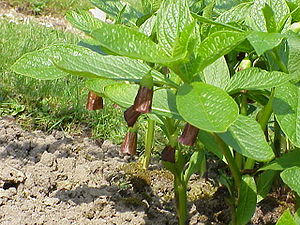Carniolan rabid
| Carniolan rabid | ||||||||||||
|---|---|---|---|---|---|---|---|---|---|---|---|---|

Carniolan rabid ( Scopolia carniolica ) |
||||||||||||
| Systematics | ||||||||||||
|
||||||||||||
| Scientific name | ||||||||||||
| Scopolia carniolica | ||||||||||||
| Jacq. |
The Carniolan rabid ( Scopolia carniolica , syn .: Hyoscyamus scopolia ) is a species of the genus madness ( Scopolia ) in the nightshade family (Solanaceae).
features
The Carniolan rabid is a perennial plant that reaches heights of 20 to 60 centimeters. The plant is bare. The leaves are toothed or imperforate. The crown is 2 to 3 centimeters long, has a diameter of 1 to 1.5 centimeters and is more than twice as long as the calyx. Outside it is dark brown-violet to reddish-violet in color, inside yellowish to brown-green. The corolla lobes are short and not very noticeable. The capsule is egg-shaped and lies close to the ovary.
Flowering time is from April to May.
The number of chromosomes is 2n = 46.
pharmacology
Carniolan rabid herb contains 0.2–0.4% alkaloids in the leaves and up to 0.5% in the roots . The main alkaloid is hyoscyamine , alongside L- scopolamine , cuskhygrin and tropine , among others . The coumarins scopolin and scopoletin as well as chlorogenic acid can also be detected. The highest concentration of active ingredients is at the beginning of the flowering period and during fruit development. Due to the ingredients, the Carniolan rabid can be seen as a highly poisonous plant. Oral ingestion of plant parts leads to symptoms of poisoning with vomiting, reddening of the face, dry mouth, mydriasis (dilation of the pupil) and, at higher doses, a delirious hallucinogenic effect as well as central nervous symptoms with cramps, visual and speech disorders. Death can be caused by respiratory paralysis. A life-threatening concentration of toxins is reached in adults with an ingestion of approx. 3 mg alkaloids, in children fatal poisoning has already been recorded after an ingestion of approx. 2 mg alkaloids.
Occurrence
Carniolan madness is found in Southeast Europe in deciduous forests, bushes and herbaceous vegetation, also in mountainous areas. The distribution area includes Austria, Poland, the Czech Republic, Slovakia, Hungary, Lithuania, Moldova, Ukraine, Croatia, Italy, Slovenia, Serbia, Romania, Georgia and the Caucasus region.
use
Carniolan rabid is used as an ornamental plant in herbaceous beds. It has been in culture since the 18th century at the latest. In the past, the plant was used as a pleasure plant (e.g. as a beverage additive, through smoking) as well as in folk medicine for rheumatic diseases, toothache, colic, sleep disorders and aphrodisiac . It was probably also used in witch ointments . The industry is used to produce L-hyoscyamine or atropine .
photos
supporting documents
Individual evidence
- ↑ a b c d e Andreas Alberts, Peter Mullen: Psychoactive plants, mushrooms and animals. Kosmos-Verlag, Stuttgart 2006, ISBN 3-440-10749-3 .
- ↑ Scopolia carniolica at Tropicos.org. In: IPCN Chromosome Reports . Missouri Botanical Garden, St. Louis
- ^ Lutz Roth, Max Daunderer , Kurt Kormann: Poison Plants - Plant Poisons, 6th Edition, NIKOL Verlag, ISBN 978-3-86820-009-6 .
- ^ Scopolia in the Germplasm Resources Information Network (GRIN), USDA , ARS , National Genetic Resources Program. National Germplasm Resources Laboratory, Beltsville, Maryland. Retrieved December 2, 2017.
literature
- Eckehart J. Jäger, Friedrich Ebel, Peter Hanelt, Gerd K. Müller (eds.): Rothmaler excursion flora from Germany. Volume 5: Herbaceous ornamental and useful plants . Spectrum Academic Publishing House, Berlin Heidelberg 2008, ISBN 978-3-8274-0918-8 .




